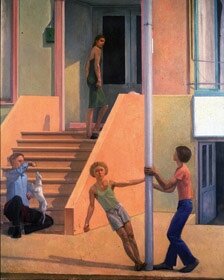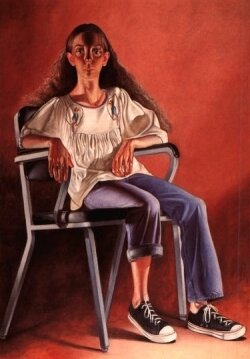That '70s show: UVA paints an era
No artist works in a vacuum. Whether consciously or un-, artists constantly respond to a host of factors: exposure to other artwork, the immediate environment, ideas discussed with creative types, political, economic, and social circumstances, etc. But inevitably, what seems radical at the moment will fade to unremarkable in the future.
So, reinvigorating the zeitgeist of the era was curator Andrea Douglas’s challenge in organizing “Excavating New Ground: American Art in the 1970s,” currently on view at the University of Virginia Art Museum. Douglas selected 13 paintings and one sculpture from the Museum’s permanent collection, most of them monumental in size, to reflect the “big” East Coast ideas of the period, which included a both/and rather than either/or approach to formerly clear-cut divisions like realism and abstraction, sculpture and painting.
Douglas points out such inclusiveness may seem commonplace in 2011, but in the 1970s, it was so new that art critics were at a loss how to discuss it. To emphasize this generation gap, the exhibit includes five episodes from All in the Family, the ‘70s sitcom that addressed social issues from the Vietnam War and its aftermath to establishing equal rights for women and minorities. Although none of the artworks explicitly deal with such topics, the videos establish a social/cultural/political context for the artists’ aesthetic choices.
Douglas cleverly juxtaposes abstracts with figurative paintings to draw attention to similar considerations of color and approaches to organization within the frame. For instance, the royal blue circle at the center of Thomas Downing’s geometric abstract, “IV IV IV” provides a focal return for the viewer’s eye that parallels the effect of the blue-shirted woman in the middle of Bruno Civitico’s realistic “Death of Eudamidas.”
Many of the figurative works showcase the hyperrealism that arose during the 1970s, a style in which details are articulated to the point of exaggeration, leading, ironically, to an awareness of the artifice of the image. The emphasis shifts from accurate portrayal to the painting process itself. In “Dina Cheyette,” for example, Alfred Leslie’s dramatic lighting and a larger-than-life figure create a riveting yet teasingly unreal depiction of his subject.
Perhaps Lynton Wells’s four-panel painting, “WYWY 74–75 (Stretchers),” best summarizes the artistic energies of the era, moving viewers back and forth between areas of photographic realism and areas of abstraction. In an era aspiring to social inclusiveness, 1970s artists radically realized they could embrace several directions at once.
~
“Excavating New Ground: American Art in the 1970s” is on view through August 14 at the University of Virginia Art Museum. 155 Rugby Road. 924-3592.


2 comments
The Lennart Anderson painting " St Marks Place" is one of my favorites in the museum collection. If you've never seen it don't miss the chance to do so now. The museum has an especially strong collection of paintings from this period, thanks to the foresight of former Bayly Museum of Art director, David B. Lawall.
Lets hear it for David Lawall and his assistant, Stephen Margulies(sp?). The both did absolutely heroic work to collect from that era and revive a dead museum.